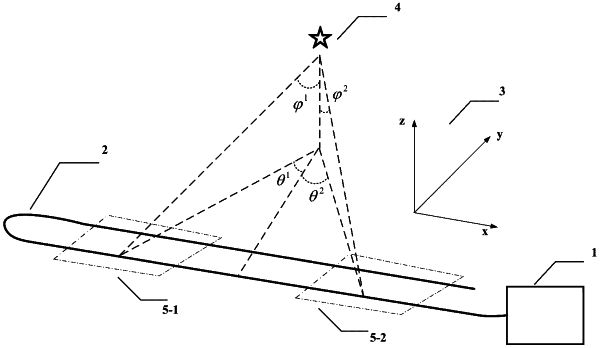| CPC G01D 5/35325 (2013.01) [G01D 5/35364 (2013.01)] | 15 Claims |

|
1. A multi-dimensional spatial positioning system for disturbance source, wherein the multi-dimensional spatial positioning system at least comprises a distributed optical fiber acoustic sensor, a sensing optical fiber, a disturbance source to be monitored and a coordinate system, wherein the distributed optical fiber acoustic sensor is coupled to the sensing optical fiber, the distributed optical fiber acoustic sensor emits detection light pulses to the sensing optical fiber, so that sound field distribution signals are obtained, the sound field distribution signals and a laying mode of the sensing optical fiber are processed, a key parameter of the disturbance source to be monitored relative to the sensing optical fiber is obtained, and spatial position coordinates of the disturbance source are calculated;
wherein the key parameter at least comprises one or more of a azimuth angle, a pitch angle, a transverse distance, a radial distance, a sound speed and a frequency;
the laying mode of the sensing optical fiber comprises one or more of a two-dimensional space laying mode and a three-dimensional space laying mode;
wherein the positioning system obtains the sound field distribution signals and processes the sound field distribution signals according to the following steps:
step 1): setting up one coordinate system (x, y, z) in a three-dimensional space, laying a sensing optical fiber in a laying mode recorded as T[x, y, z], the distributed optical fiber acoustic sensor emitting detection light pulses to the sensing optical fiber via the distributed optical fiber acoustic sensor, and quantitatively detecting a sound field along the sensing optical fiber to obtain sound field signals S(l, t) distributing along the optical fiber, wherein t represents time, l represents one-dimensional axial spatial coordinates of the sensing fiber;
Step 2): pre-processing the obtained sound field signals S(l, t) distributing along the optical fiber:
firstly, performing a coordinate system transformation of the sound field signals S(l, t) distributing along the optical fiber, thereby obtaining a distribution Sd(x, y, z, t)=T[S(z, t)] of the sound field distribution signals within a space formed by the sensing optical fiber,
secondly, determining a center frequency f0 of the disturbance source to be monitored, setting an sound field intensity threshold E by a data processing unit according to each disturbance source to be monitored, and searching for an area to be detected Ω(x, y, z) where the sound field intensity is greater than the threshold E in a sound field distribution signals Sd(l, t), and selecting a sound field time-domain signal matrix formed by n adjacent sound field sampling signals as a first signal group within the area to be detected Ω(x, y, z), wherein a direct distance between the sound field sampling signals is as close as possible to
 (wherein ν is a propagation rate of sound waves in a medium), the first signal group is expressed as follows:
X1(x,y,z,t)=[Sd(x1,y1,z1,t)Sd(x2,y2,z2,t) . . . Sd(xn,yn,zn,t)]T
wherein a sum of transverse dimensions of spaces occupied by the adjacent n sound field sampling signals of the first signal group is L, and the n is greater than m being a number of disturbance source(s) greater than or equal to 1, that is, when there are multiple disturbance sources, it is necessary to ensure that the sound field sampling signals of each signal group outnumber the disturbance sources, so as to avoid signal interference between different disturbance sources and improve monitoring accuracy;
step 3): applying an array signal processing method to the signal group in the step 2) to calculate the spatial position coordinates of the disturbance source to be monitored.
|